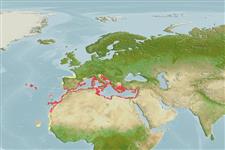>
Eupercaria/misc (Various families in series Eupercaria) >
Scaridae (Parrotfishes) > Sparisomatinae
Etymology: Sparisoma: Latin, sparus = a fish with a golden head + Greek, soma = body (Ref. 45335).
More on author: Linnaeus.
Issue
Sister species: Sparisoma strigatum (Ref. 101637).
Environment: milieu / climate zone / depth range / distribution range
Écologie
marin récifal; profondeur 20 - 50 m (Ref. 27000). Subtropical; 46°N - 12°N, 32°W - 36°E
Eastern Atlantic: Portugal, Azores and Madeira south to the Canary Islands and Senegal. Mediterranean Sea: more common in the eastern and southern coasts.
Length at first maturity / Taille / Poids / Âge
Maturity: Lm 15.5 range ? - ? cm
Max length : 50.0 cm TL mâle / non sexé; (Ref. 7360); common length : 30.0 cm SL mâle / non sexé; (Ref. 6761)
In shallow water along rocky shores. Feed on algae and small invertebrates (Ref. 6761, 56146). Herbivore species with specialized pharyngeal bones and muscles (Ref. 52194, 52195). Breeding occurs from July to September, with juveniles recruiting in late summer in Portugal (Ref. 56146).
Life cycle and mating behavior
Maturité | Reproduction | Frai | Œufs | Fécondité | Larves
Males matured at the same ages and sizes as did females, and size ranges of males and females overlapped, strongly suggesting gonochorism for this species (Ref. 103751).
Randall, J.E., 1990. Scaridae. p. 883-887. In J.C. Quero, J.C. Hureau, C. Karrer, A. Post and L. Saldanha (eds.) Check-list of the fishes of the eastern tropical Atlantic (CLOFETA). JNICT, Lisbon; SEI, Paris; and UNESCO, Paris. Vol. 2. (Ref. 7360)
Statut dans la liste rouge de l'IUCN (Ref. 130435: Version 2024-1)
Menace pour l'homme
Harmless
Utilisations par l'homme
Pêcheries: commercial
Outils
Articles particuliers
Télécharger en XML
Sources Internet
Estimates based on models
Preferred temperature (Ref.
123201): 15.1 - 20.3, mean 17.1 °C (based on 34 cells).
Phylogenetic diversity index (Ref.
82804): PD
50 = 0.5000 [Uniqueness, from 0.5 = low to 2.0 = high].
Bayesian length-weight: a=0.01047 (0.00847 - 0.01294), b=3.08 (3.03 - 3.13), in cm total length, based on LWR estimates for this species (Ref.
93245).
Niveau trophique (Ref.
69278): 2.9 ±0.27 se; based on food items.
Generation time: 3.7 ( na - na) years. Estimated as median ln(3)/K based on 1
growth studies.
Résilience (Ref.
120179): Milieu, temps minimum de doublement de population : 1,4 à 4,4 années (K=0.16; tmax=8).
Prior r = 0.48, 95% CL = 0.32 - 0.72, Based on 2 data-limited stock assessments.
Fishing Vulnerability (Ref.
59153): Moderate vulnerability (36 of 100).
Climate Vulnerability (Ref.
125649): High vulnerability (58 of 100).
Nutrients (Ref.
124155): Calcium = 21.7 [12.4, 49.8] mg/100g; Iron = 0.569 [0.307, 0.968] mg/100g; Protein = 19.3 [17.2, 21.6] %; Omega3 = 0.172 [0.094, 0.286] g/100g; Selenium = 16.1 [7.9, 29.2] μg/100g; VitaminA = 37.5 [13.3, 109.1] μg/100g; Zinc = 0.869 [0.585, 1.412] mg/100g (wet weight); based on
nutrient studies.
